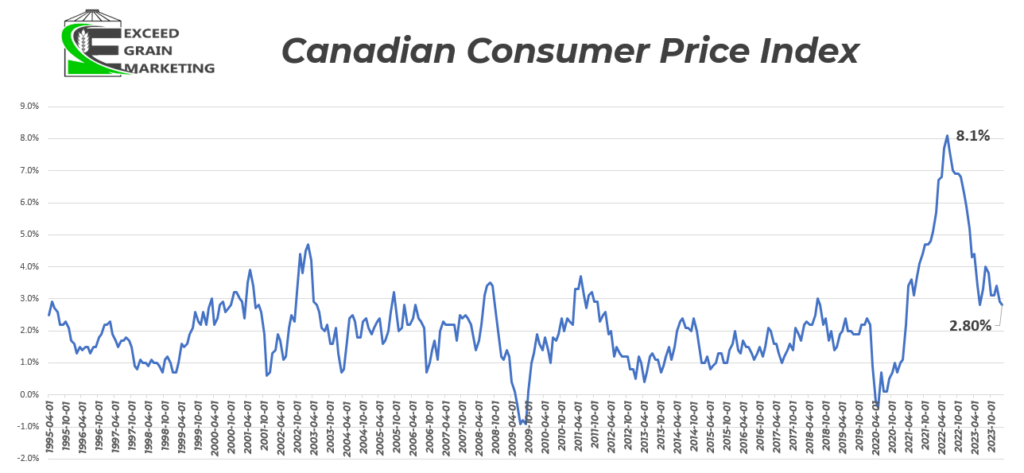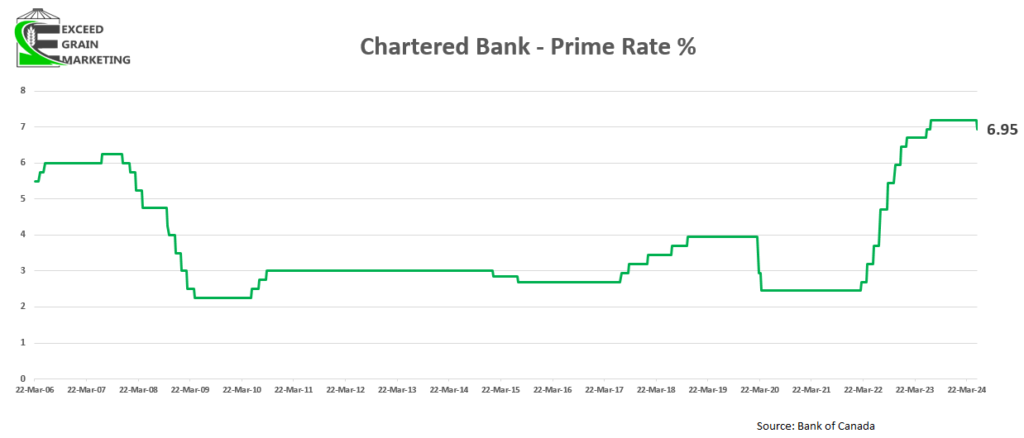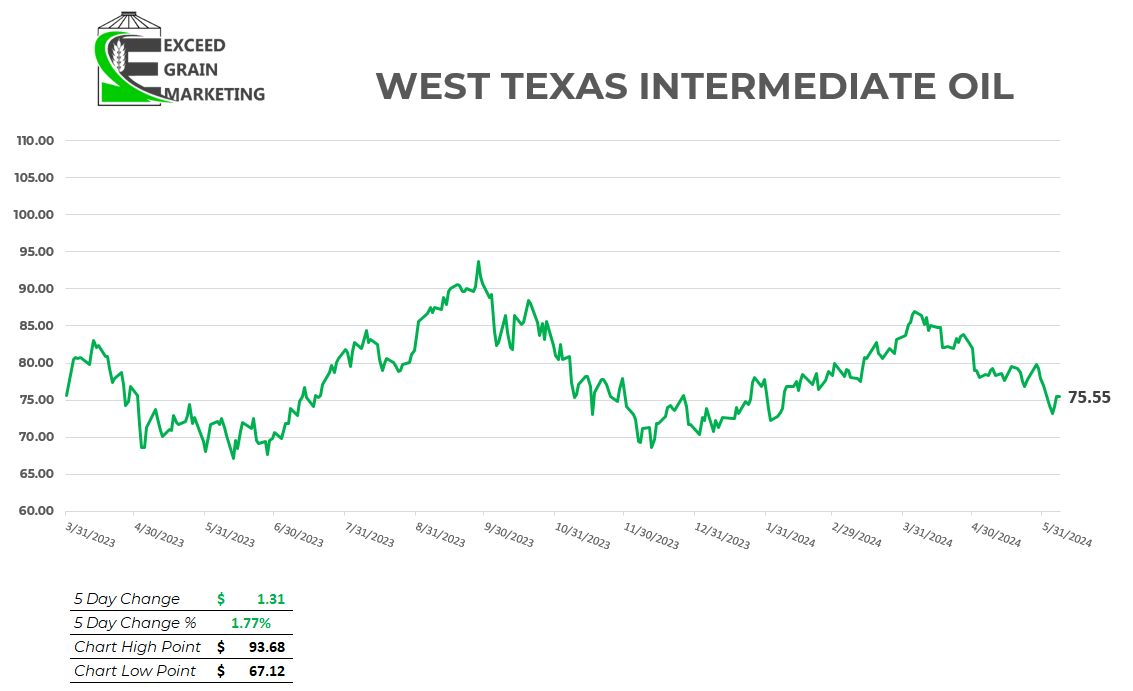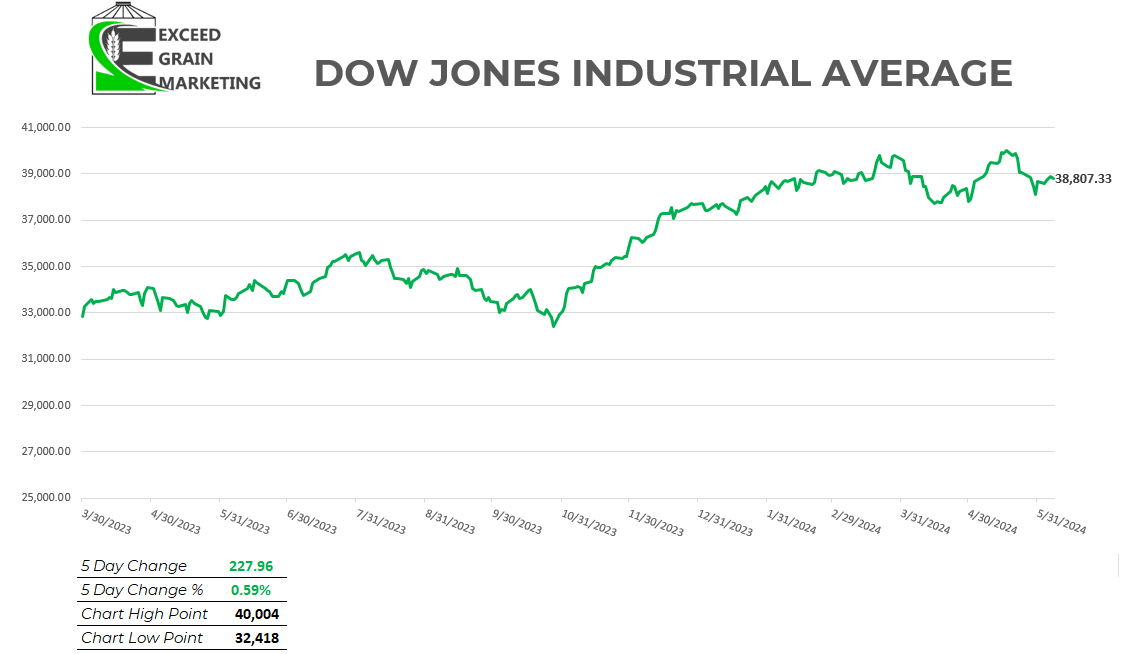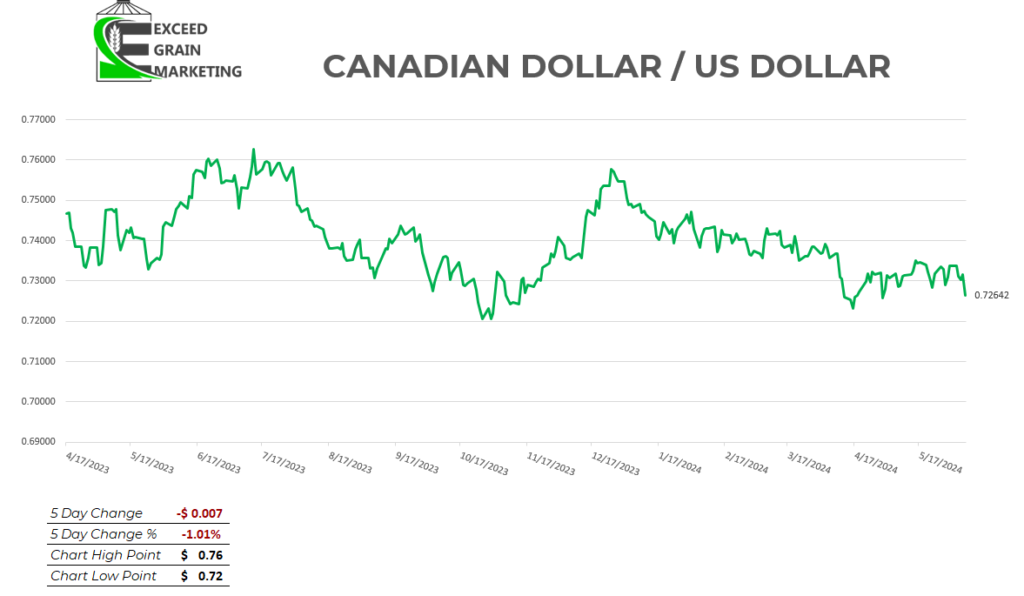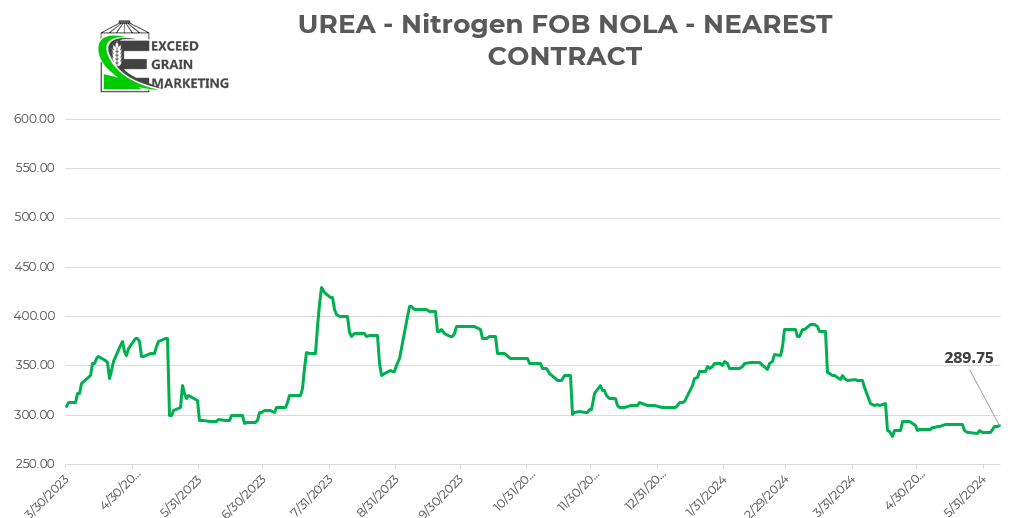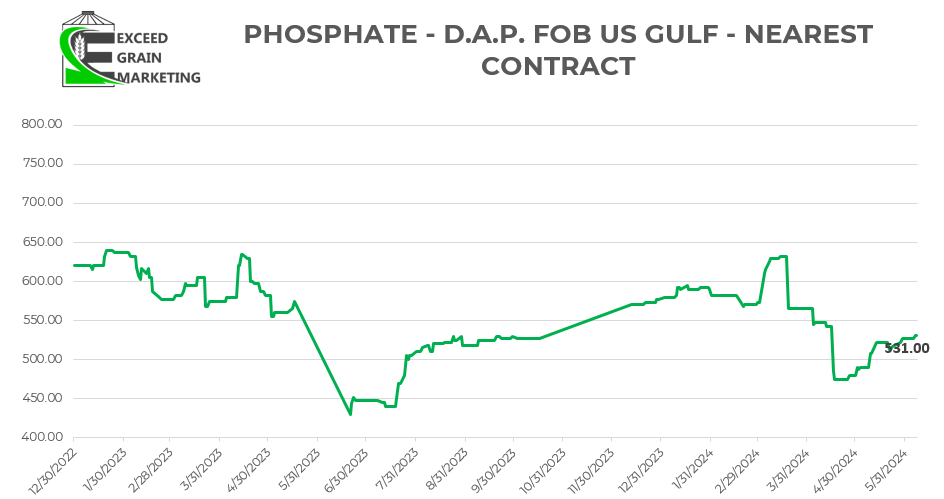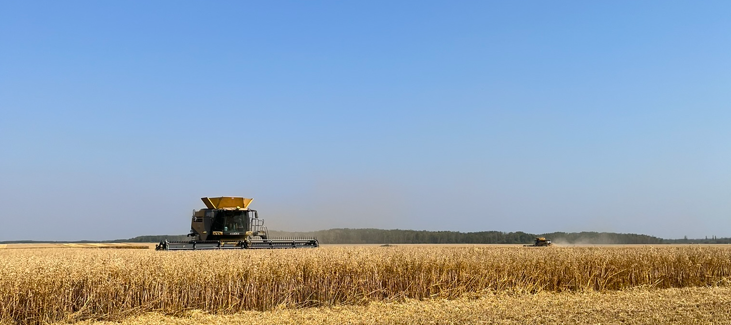Exceed Grain Marketing’s Client Exclusive report is dedicated to covering the ongoing trends and significant highlights within the local market, while simultaneously offering a perspective on the global landscape. This approach ensures a comprehensive understanding of the factors influencing the market at both local and international levels. Our aim is to deliver current, up-to-date information specifically tailored to the crops impacting your operation. Work with your Exceed Grain Marketing advisor to devise specific strategies that may work for your crop.
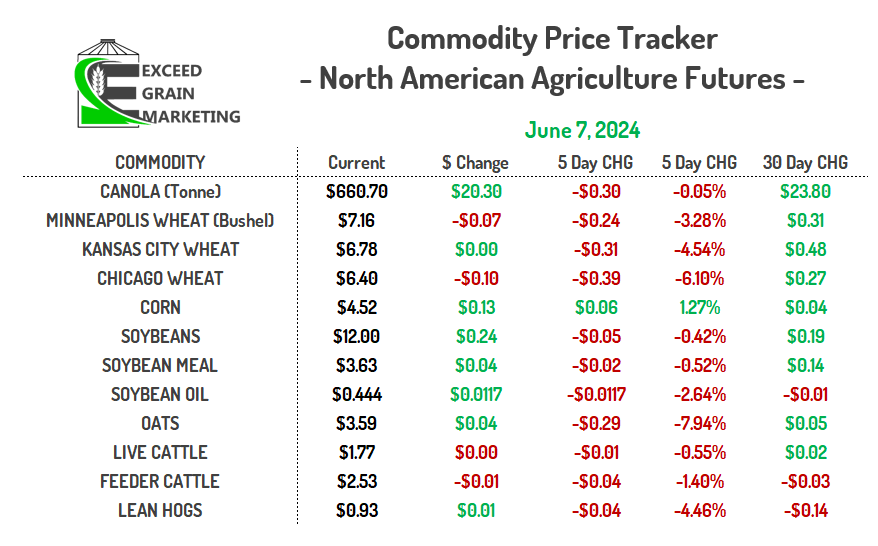
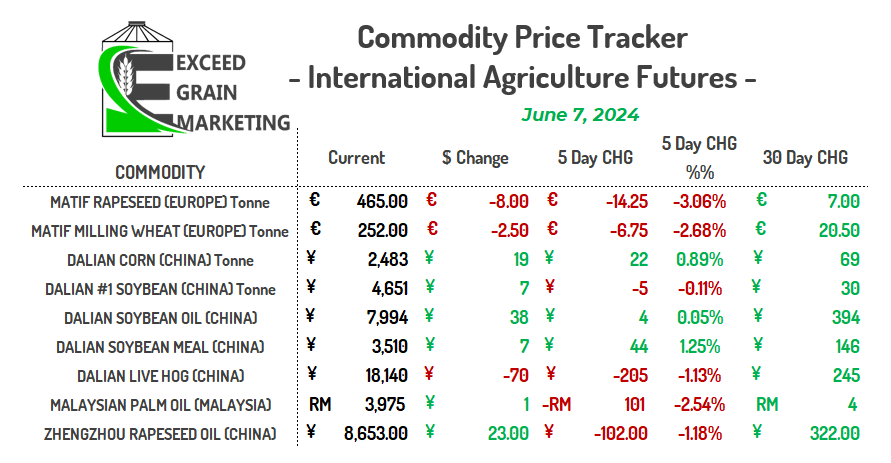
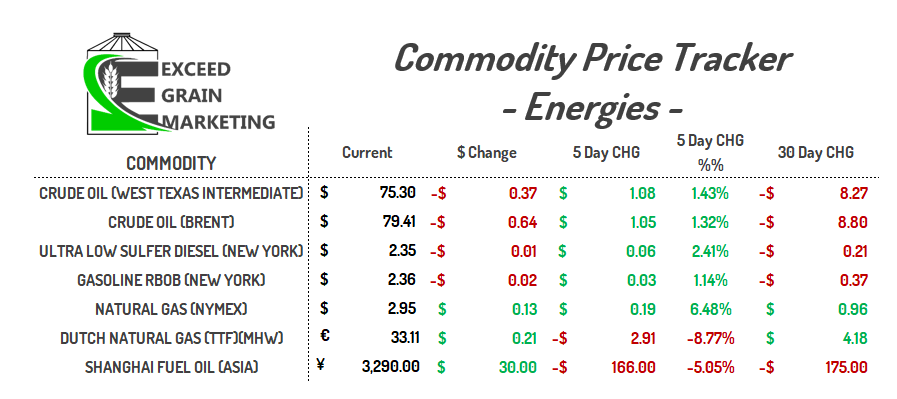
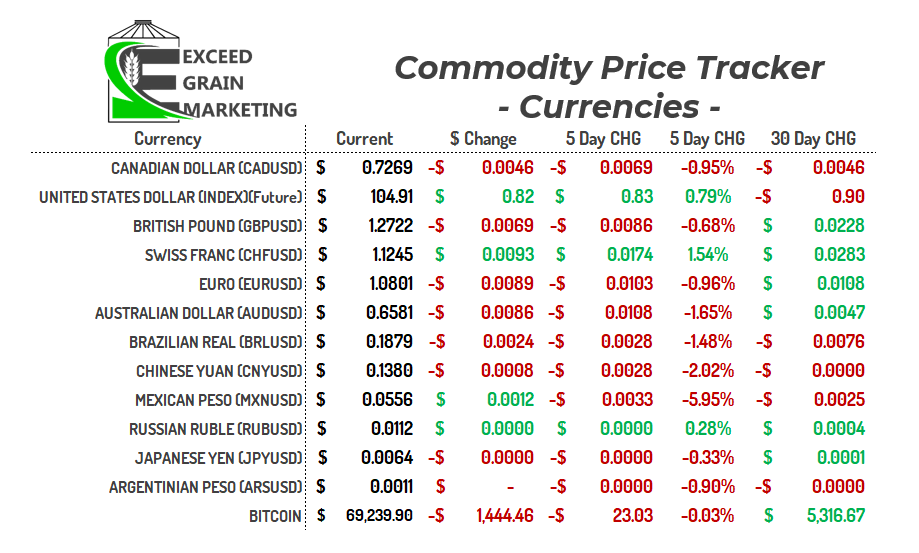
MARKET HIGHLIGHTS
- Link to Latest Canola Fundamentals Report
- 2024/25 Crop Year Recommendations – Click Link
- Markets take a slide for the week, aside from a major bounce on Thursdays trade for oilseeds, markets closed lower into the Friday session.
- Wheat closed lower for the 8th session and is putting on an extended period of lower closes. Last time wheat markets closed lower for 9 sessions or more was nearly a decade ago.
- General commodity selloff for the week in Ag’s globally. Palm Oil, Rapeseed, EURO Wheat all took a step back.
- Markets looking towards next Wednesday USDA WASDE report. We will also get the first look at Soybean crop conditions for the United States crop on Monday afternoon
- For the WASDE, Markets will be watching to see how they treat recent issues with the Black Sea crop. USDA was at 88mmt, Russian government at 85mmt and private analysts toying with the 80 or sub that level mmt mark. USDA in May has US ending stocks to usage at the tightest in 10 years.
- Russia imposed a “State of Emergency” today for the 10 regions affected by the Frost and Drought earlier in May. This is what drove the markets higher for the month of May and has been put on the backburner for the time being as markets pullback. Russian crop will start being harvested here by the end of June / early July.
- US wheat crop coming off in Kansas, Oklahoma regions. The crop coming off with better yields than other years, some disease issues but the crop is mostly coming in as expected.
- Western Australia did end up receiving some critical rains in the past week. Over an inch fell in some of the driest areas. The crop is just finished up planting and was a “million dollar rain” as the adage recites.
- French wheat conditions sit at 62%, up from 61% this week. Was 91% last year.
- US new crop soybean sales sit at the worst start to the marketing year in around 20 years. As of last week, only 35 million bushels have been spoken for the new crop, about 1/3 of last years commitments by this time already. Still very very early in the marketing year so not gaining a lot of attention yet at this point.
- European Union released their tariff guidelines yesterday for Russian and Belarussian grain imports. As of July 1st it is being reported that cereal crops (wheat, barley, ect) will be subject to a 95 euro per tonne tariff into the EU and oilseeds will be 50% tariff.
- Canadian April crush came in at 958 thousand tonnes. On pace for a record crush year. 8.3 mmt have been crushed through end of April, about 1mmt more than the long term average pace. Exports on pace for 6.5mmt
- USDA WASDE May Edition: Charts are above but we will list a few of the key takeaways of the report:
- This was the first report with crop production estimates for the 2024/25 crop report.
- South American crop production trimmed 4mmt off of the corn estimates, but came in fairly close to market estimates prior to the report. For the soybean crop, USDA cut 1mmt off the Brazil crop and left Argentina untouched. The pre report estimates were actually estimating around about 2.5 mmt cut, so came in higher than pre report estimates.
- Global Rapeseed ending stocks came in higher than the month prior. 8.43 vs 7.83 mmt last month.
- 2024/25 New Crop global estimates for the crop came in at 7.82 mmt
- 2024/25 World Ending stocks were published for the first time this year:
- 312.3 mmt corn
- 128.5 mmt soybean
- 253.6 mmt wheat
- Corn came in about 5mmt less than pre report estimates, albeit the first report of the marketing year
- Wheat came in about 4mmt less than pre report estimates.
- CN and CPKC railway employees,
Canada’s two major rail systems have voted to start striking as of May 22nd if their contract is not renewed to their standards. This would be very significant to export movement if not resolved before that time.Update to this story below:- Federal Government Minister Seamus O’Regan has asked the Canadian Industry Relations Board to look into the safety implications of the strike. A strike can not begin until a decision has been made. late June or July would be the estimated earliest possible strike being reported.
- Looks like market will loose around 3 million tonnes of soybeans in RGDS state of southern Brazil due to the historic flooding of April / May/ Quality reported to be of very poor condition. The tonnage will be there, just the quality is questionable at best after spending significant time in water logged conditions.
- North American producers will welcome India’s extension of the Yellow Pea tariff exemption. Yellow pea imports will remain exempt from import duties until October 31st, 2024. Moving the exemption into the new crop season. Domestic yellow pea bids have increased as a result.
- Desi chickpeas will now be exempt from tariffs until March 2025.
- Sounds like Australia has turned to planting more Desi Chickpeas this year, especially in Western Australia. Acres up 80%
- Australia is expected to plant a record 885,000 acres of lentils
- Frost in parts of Germany and Poland late April / Early May has private analysts down to around 17.8 mmt. Last year around 20mmt
- The narrative has already begun that EU will need to import around 6mmt of Rapeseed/Canola for the upcoming campaign. This past year Canada missed out on most EU business in favor of Ukraine and Australian origin of cheaper origin. Market will be watching this closely as to how it will develop from here forwards.
- Strategie Grains, French Private Analysts place EU barley up 10% year over year. April estimated Rapeseed production at 18.1 mmt vs 18.3 month prior, 19.9 mmt was the production number last year.
- Recommendations Page Updated at Bottom of Report
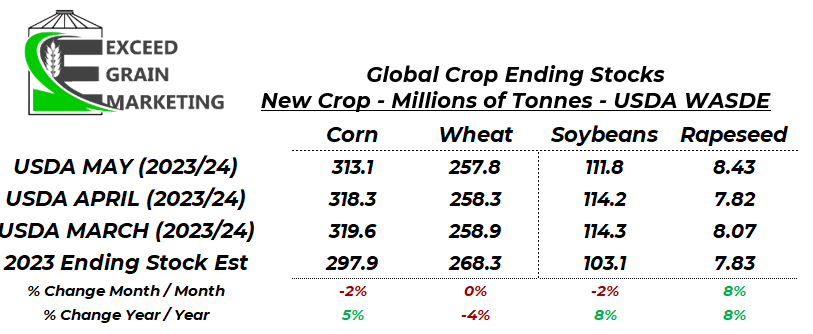
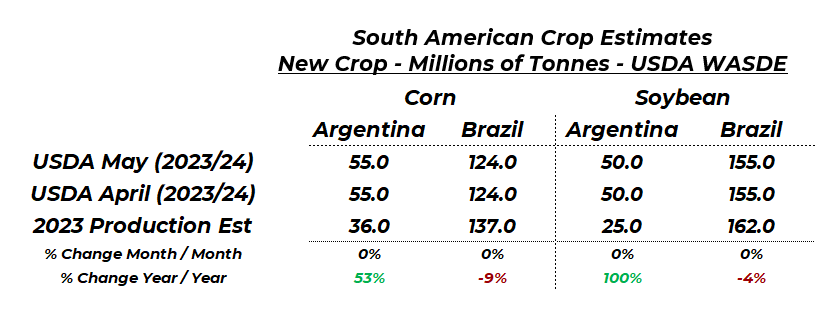

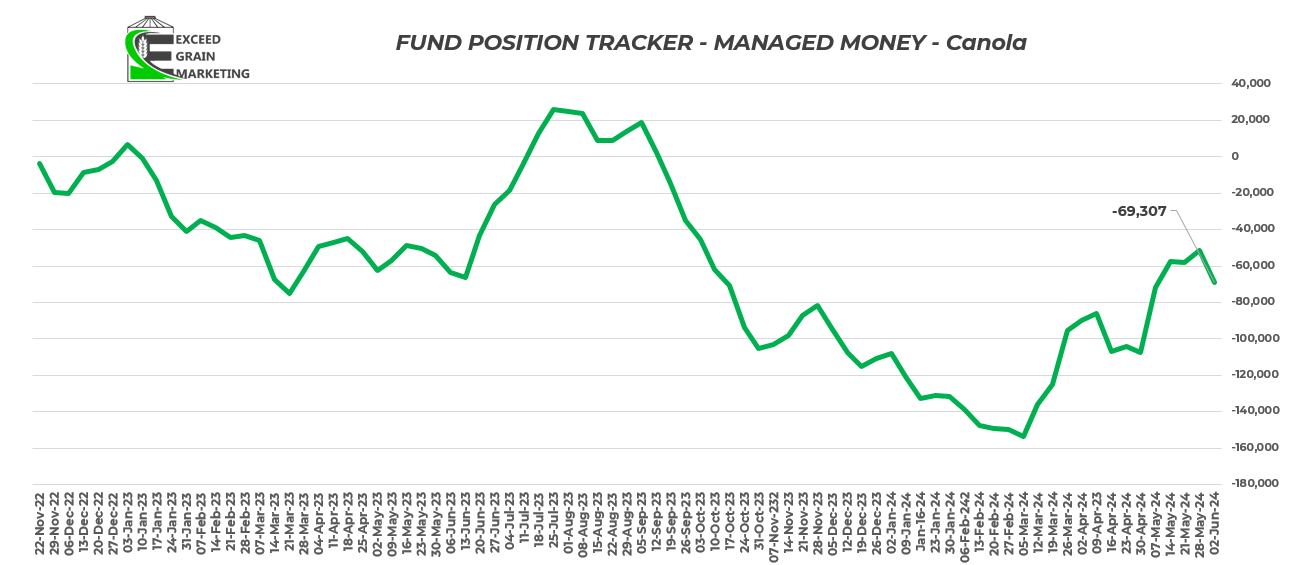

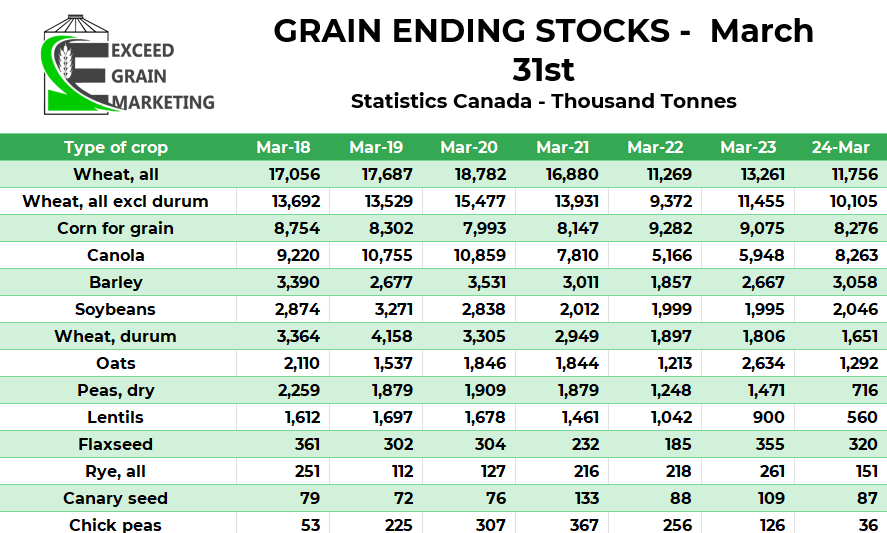
WESTERN CANADIAN CROP NOTES
Canola:
- Crush margins narrowing up. Vegoil values have took a hit and the oil share of the crush is worth less, significant for canola as that’s traditionally where most of the crush value sits. Crush margins were close to $200 per tonne February 2024 vs $130 range today.
- We hit some important sales targets for our grain marketing clients in past few weeks due to the recent run up in futures from the February lows. See recommendation section below. July Canola is now the front month for marketing purposes.
- Be sure to be looking at important dates for rolling forward any basis if required. Mid June is often when many grain buyers need to know if rolling or pricing.
- Crushers filling up domestically for the front months as producer selling took up much of the front month capacity. Most crushers bidding July onwards. If need crusher movement, need to build a plan around that. July/August is where most capacity lies within the crush. Be cognizant of export and crush capacity as we get closer to the dates.
- Canola now once again pricing more expensive than Australian Canola after being cheaper than them in late February and into early March. The difference between exporter bids has narrowed up significantly in recent weeks. Canola carried such a premium to Australian canola and EU canola through the first half of the marketing year. It narrowed up significantly for several week but is showing signs of building that spread again. Chart above shows most recent bids at some key export/import regions in Canada, Germany, Australia and England.
- Canola export current pace of 6.5+ mmt is not great overall and would be one of the lowest levels of exports in decades. See chart below for reference
- We need to grab exports on the tail end of the marketing year to maintain a reasonable carryout in the market. We have 10 weeks of export left in this marketing year. Need consistent movement here on forwards
- Crush is running at a very impressive pace, looks like we will surpass and hit a 11mmt + record. Markets need to see exports pick up to get any sort of strength into the domestic trade (Basis).
- Crusher bids still dominate but are falling closer to exporter prices, depending on the month. Crushers hold the winning bid for new crop 2024 harvest
- For a more in depth analysis on Canola Specifically, check out our June 2024 Canola Fundamental report by clicking here: Canadian Canola Market Fundamentals – June 2024
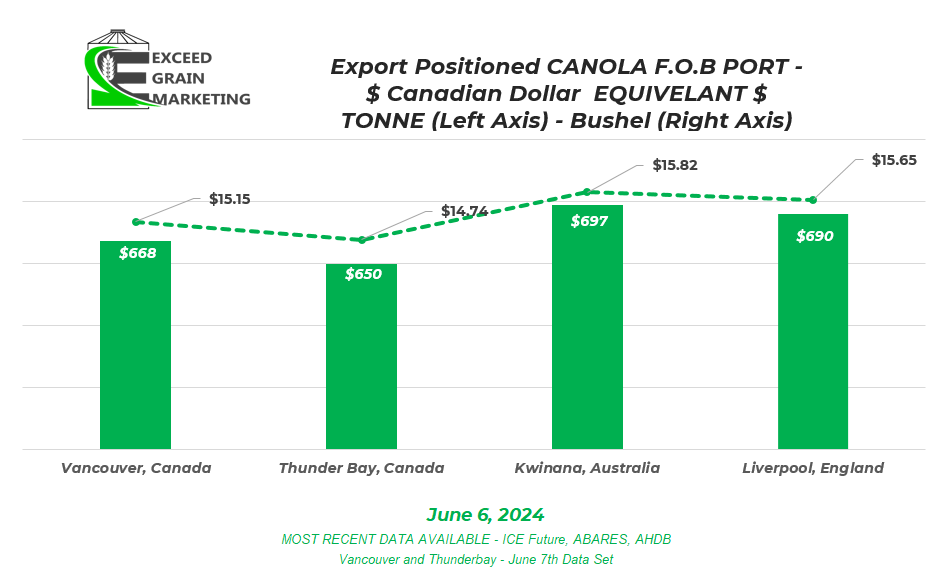
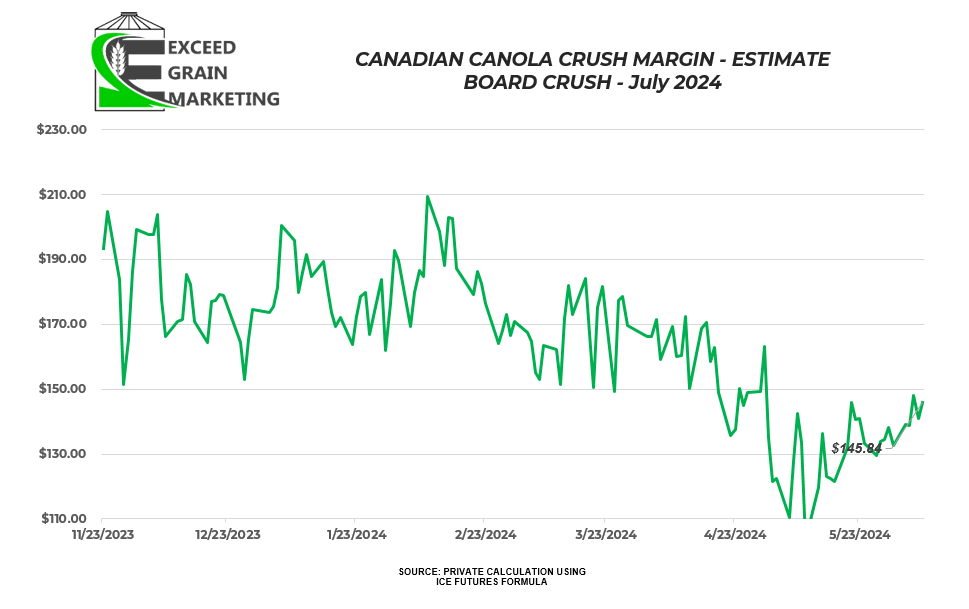
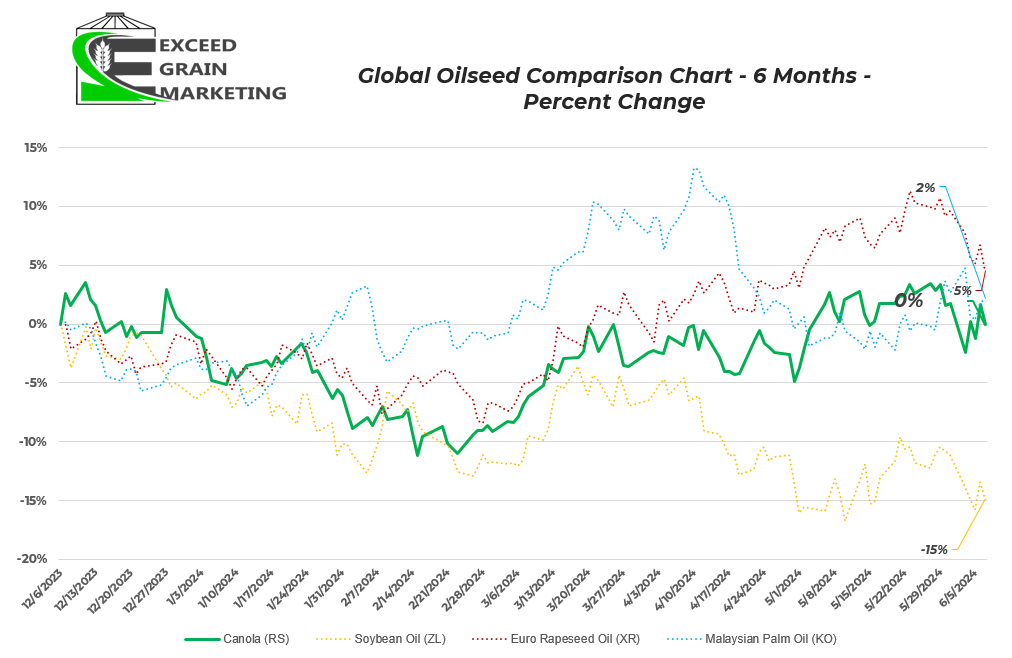
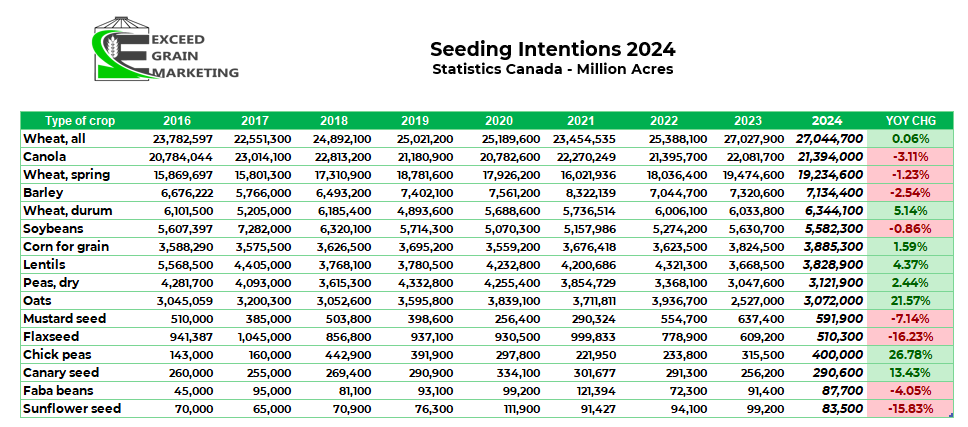
Spring Wheat:
- Algeria and Egypt tendered for 1.2 mmt of wheat this week.
- Russia / Black Sea weather is the driver of wheat markets. Some significant frosts in Russia in first half of May causing some havoc with crop conditions. Now dryness in the same regions have been drying and lack of rainfall during some critical crop growth periods. The wheat crop in the region typically starts its harvest early July.
- Private analysts calling the crop anywhere from 79 to 85 mmt. Was closer to 93mmt earlier in the year. The USDA posted 91.5 mmt last years crop, the year prior was argued to have been higher and closer to that 100 mmt mark unofficially. So important context when looking to compare crop sizes.
- Indian stockpiles of wheat lowest in 16 years will need to import wheat to bridge gap between shortfall and new crop.
- Oklahoma, Kansas taking off the winter wheat crop and starting to hit market.
- Kansas wheat tour wrapped up Mid May posting an estimated yield potential of 46.5 bushel per acre. This would put the Kansas winter wheat crop at 290 million bushels vs the 268 million bushels the USDA had in its latest estimate. Five year average is 44.2 bpa for the Kansas crop.
- US winter wheat harvest is beginning in its infancy stages in Texas and Oklahoma. To early to call yield prospects. Sounds like some quality issues with the Oklahoma crop early on
- Russia’s ministry of agriculture reporting that 830,000 hectares or over 2 million acres of crop were lost due to the multiple frost events of the first half of May. Privates saying atleast double this.
- Seeing Russian wheat FOB values increasing. 12.5% Protein bidding $250+ per tonne, up $5-$10 since last week. For reference, this was $215/tonne late April and closer to the $200 level mid winter.
- Crops that are severely damaged can still be planted to a spring crop, but at a yield drag and would typically be looking to target a higher protein market. None the less, it would mean less quantity of wheat if a few of the presented scenarios come to play.
- Reports of Russian farmer selling slowing down due here recently. New crop will be off beginning in July and the anecdotal sentiment is towards producers willing to sit on inventories for the time being.
- Domestic wheat bids in Western Canada touching that $9.25 to $10.00 + range for old crop. $8.50 up to $9.50 for new crop, best bids in prairies found in Alberta. Worst basis levels found eastern Saskatchewan and Northern Manitoba New crop bid spreads very wide and wide spreads across the prairies.
- Canadian Wheat exports and domestic usage is still considered very strong. At the current pace of exports and domestic usage, rationing will be needed. This does not always mean price correlates accordingly, as we have seen in recent weeks. Prices have seen producers selling into them.
- Wheat exports expected to easily surpass last years levels at current pace and are on track for an 7% increase year over year. Likely not able to make that happen although as rationing will supersede this.
- 2023 Old Crop Canadian wheat of good quality. 97% graded as either a #1 or #2 HRSW
- 80% had falling number above 350 seconds
- Wheat trade right now is mostly demand based. We have a good idea on global supplies for the most part.
- Forecasted wheat global and domestic ending stocks coming in at the tightest levels since the 2015/16 crop year.
- Keep an eye crop progress in the US and EU winter wheat crops and Spring Wheat crop conditions.
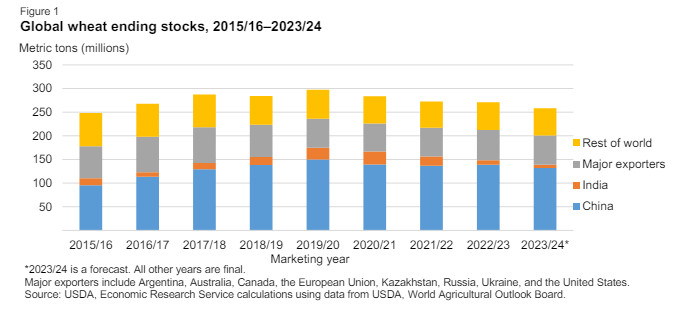
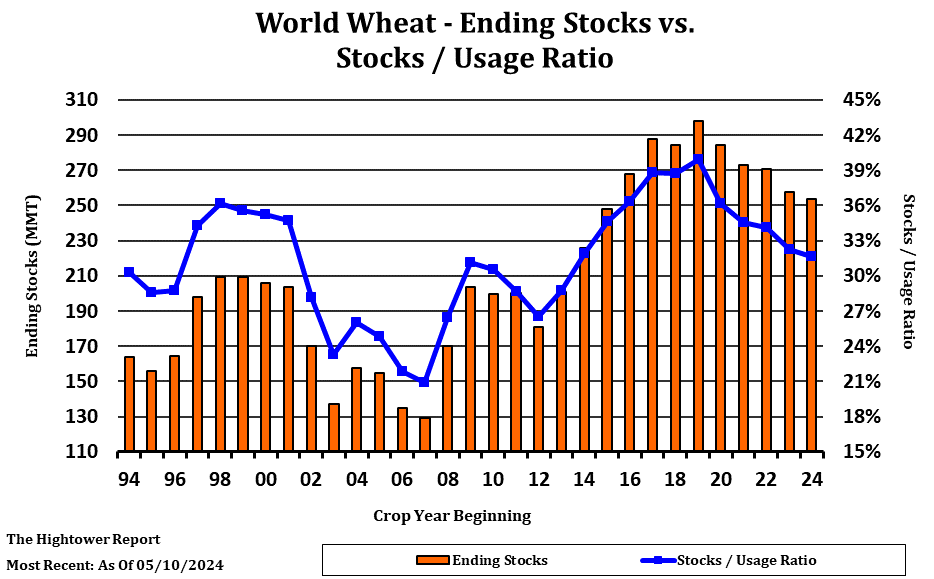
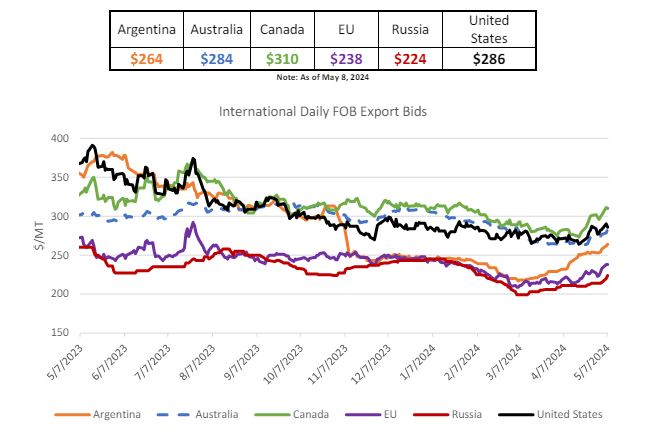
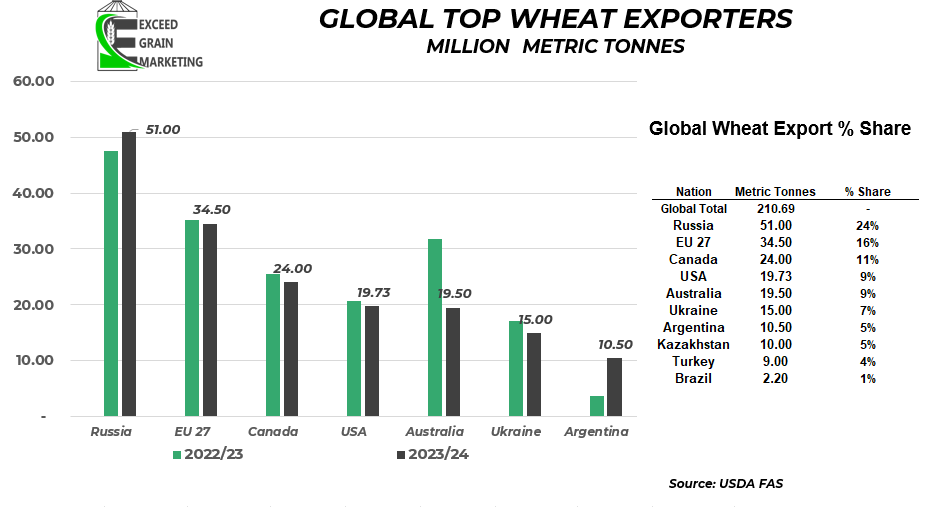
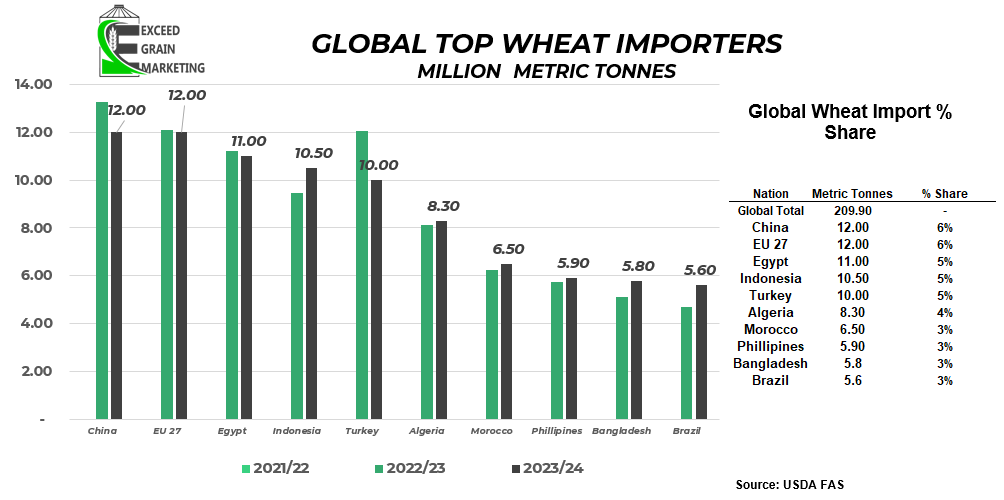
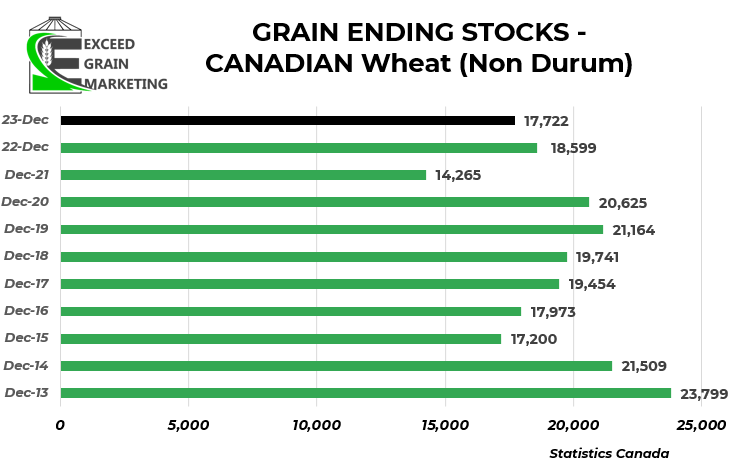
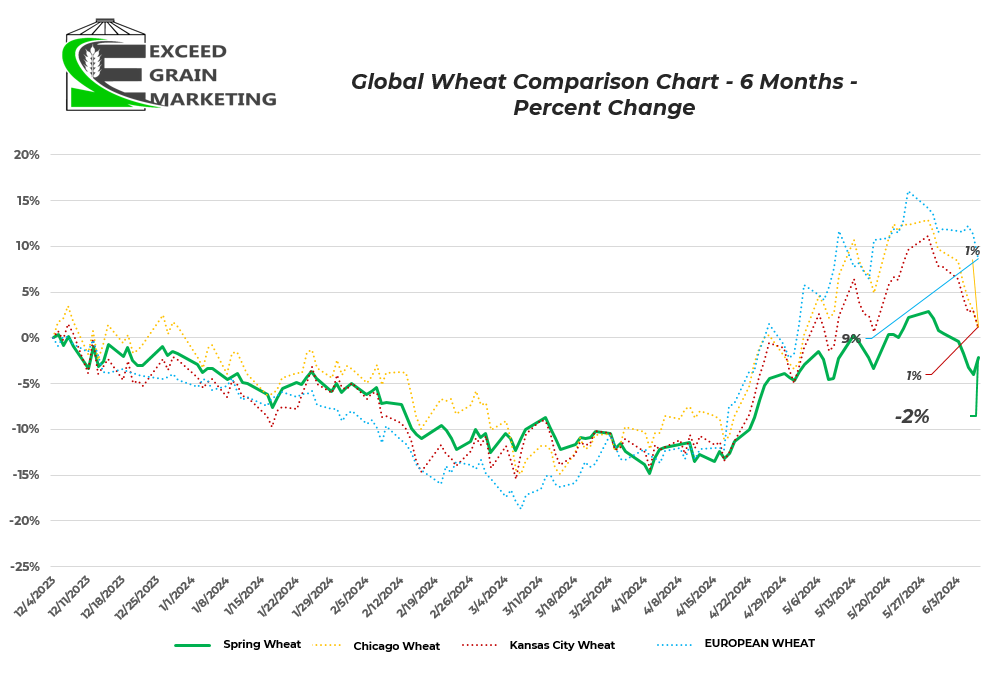
Special Crops
- Italy in midst of their Durum harvest. Mediterranean region harvest will be in full swing shortly. Yield expected to be reduced, but quality expected to be alright in general. More in the coming weeks.
- Turkey tendered for durum early May. Looks like Viterra grabbed some of the business $328 USD per tonne.
- Minimal stocks of Canary Seed in Thunder Bay has markets reduced hopes for a large spring export sale. 10,500 tonnes sitting in Thunder Bay late May.
- Yellow Pea and Lentil Acreage expected to grow in Canada for the marketing year. The pulse crops are showing some excellent return potential for the 2024 cropping season if producers can bring it to yield at harvest.
- Special crop markets closely watched Marchs release on acreage estimates from Stats Canada.
- Barley acreage drops to 7.1 million acres. Fits in line with some trendline averages
- Barley prices lower than last year, as with many crops. Some $5.00+ feed opportunities available central Sask. Greater as you move closer to Feed centers. Add $1.25 to $1.50 for Malting.
- Durum acres up 5% year over year. One of the largest acreage estimates in recent years
- Lentil and Pea acres up year over year but still not out of line with recent history.
- One thing to note from this report is that it was collected from December to January 15th. Lots has changed in this timeframe.
- Canadian peas will face stiffer competition going forwards into China as some Black Sea peas able to price into the region. Some of these peas were affected by early May frosts.
- India reduced Yellow Pea import tariffs from 50% down to 0% was extended for several months and now sits at October 31st, 2024. Was only in place until end of March but another month, and then another, was added to get exports into the nation.
- Durum growing regions of Canada have got some recent precipitation but will be dependent upon some key rains following planting, producers somewhat hesitant to price aggressively on new crop. EU prices are rising for the crop but Canadian bids appear to have plateaued for short term.
- Red Lentil reduced import tariffs extended until March of 2025
Latest Key Fundamental Report Highlights
- STATS CANADA ( DECEMBER)
- March 11th we got Principal Field Cropping Areas – See above
- December 5th production estimates. Stats Canada report came in and was mostly as expected but higher than the prior report released pre harvest.
- Canola- 18.3 mmt vs 18.3 mmt pre report estimate
- Spring Wheat – 24.7 mmt vs 24.0 mmt pre report estimate
- Barley 8.9 mmt vs 8.6 mmt pre report
- Oats 2.6 mmt vs 2.6 mmt pre report
- Durum 4.0 mmt vs 4.1 mmt pre report
- Corn 15.1 mmt vs 15.0 mmt pre report
- Soybeans 6.98 mmt
- Lentils 1.7 mmt vs 1.7 mmt pre report
- Peas 2.6 mmt vs 2.6 pre report
- Flax 0.272 vs 0.290 pre report
- Most of the production numbers are higher than they were in the early days of harvest when ideas for the canola crop were floating around a high 17’s number. Same could be said for Durum and a few other select crops.
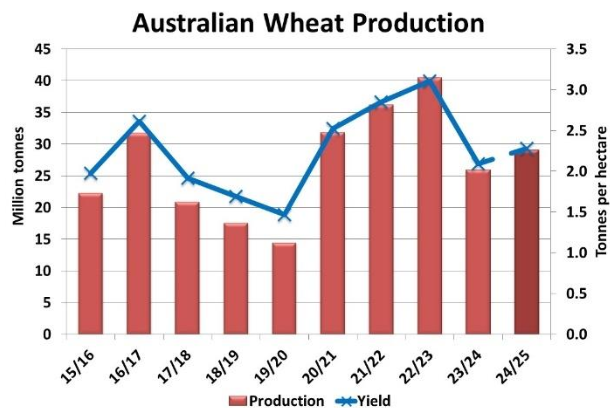
Currency – Energies – Fertilizer
- Bank of Canada Stays Put with current interest rates at the latest interest rate meeting. Prime sits around 7.2% at major Canadian banks. Hinted that we could be higher for longer. Cuts will not be significant if they do come. The Bank of Canada has also recently hinted that one could face another rate hike but it is hesitant to do so given that Canadians are feeling the pinch of higher rates.
- Analysts split if we get a rate cut in June.
